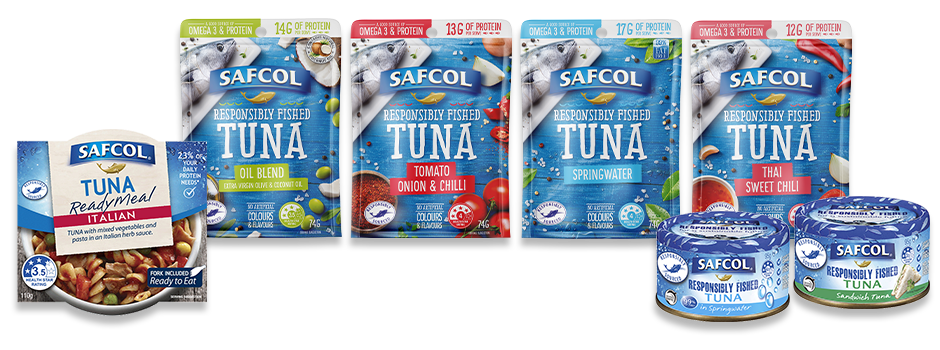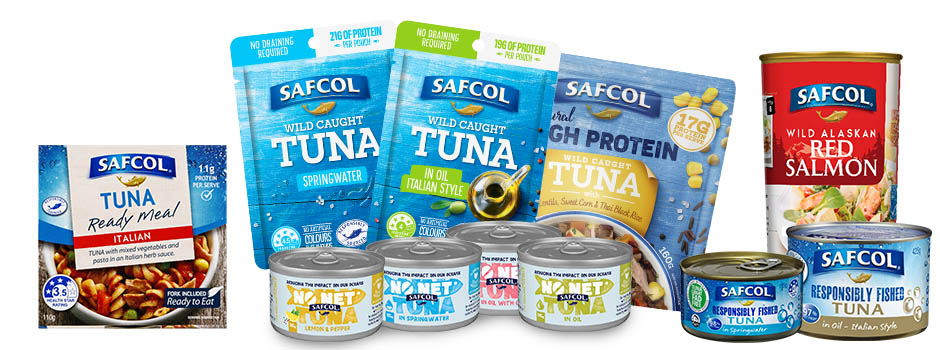
Why you should pick up a tin of Safcol Tuna for Lunch
by Ashleigh Feltham
Accredited Practising Dietitian and Accredited Nutritionist
Not only is Safcol the Seafood Experts tuna lunchbox friendly, but it also tastes delicious, and boasts some amazing health benefits! Tuna contains Omega-3 fats that are an unsaturated form of fat called polyunsaturated. These types of fats cannot be made by the body, so we need to include them as part of our diet to stay healthy.
For good health, you need omega-3 fats in our diet, particularly the type which comes from fish and seafood because it contains two acids known as docosahexaenoic acid or DHA and eicosapentaenoic acid or EPA. These two acids are linked to better health for your body particularly for your brain and heart.
The benefits of including seafood sources of Omega-3 fat in your diet
Plants, like green leafy vegetables, walnuts, pecans, almonds, soy products and linseed, also have omega-3 fats, but they contain a different type of omega -3 fat acid called alpha-linolenic acid. The body can turn this into DHA and EPA, but it’s difficult for the body to do and not very effective, so you really do need seafood sources.
The benefits of including seafood sources of Omega-3 fat in your diet include:
- the reduction of the risk of heart disease and its recurrence
- the reduction of the risk of heart failure and stroke as well as reduction of high cholesterol.
DHA and EPA can also help to regulate your heartbeat, decrease blood clotting and reduce high blood pressure.

Secondly, eating fish can reduce inflammation. Inflammation can be a good thing when the body is in balance but too much inflammation is linked to conditions like rheumatoid arthritis, DHA and EPA can help reduce inflammation in your body. One review suggests omega-3 fat may reduce the risk and reoccurrence of breast cancer, although more evidence is needed in this area.
Do you want to improve your memory and reaction time? Then make sure you get enough DHA! A strong study design found healthy adults who included DHA in their diets have improved moments and reaction time compared to those with low levels of DHA.
Another benefit to the brain is a reduced risk of dementia, especially Alzheimer’s disease.
Eating fish may also help you lose weight! Two stronger forms of study types found people who ate fish lost more weight and reduced their waist circumference more than those who did not eat fish. Although more evidence is needed of the effect over a longer time.
So how much fish is enough?
It is recommended to include fish in your diet 2-3 times a week. A serving is 100g of fish and the oiler the fish the better. Oily fish is fish like salmon, Mackerel, Sardines, Herring, Arctic Char, Anchovies or Trout but any seafood source is better than none. Two ways to include fish is to take a tin of Safcol tuna or salmon as a snack or to add to some wholegrain crackers. Add some tuna to a pasta and tomato dish for lunch. Experiment with different types of fish and seafood see the many ways you can enjoy incorporating seafood in your diet.
Make sure you are giving your body a healthy advantage by including fish in your diet. The best tasting tuna variety hands down must be Safcol the Seafood Experts tuna. So make sure you stock up next time you are at the supermarket as there are many varieties to enjoy in your week. There are many serving suggestions on the Seafood Experts website.

